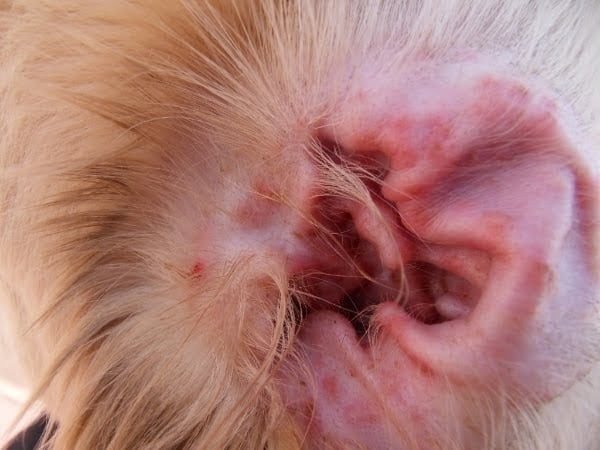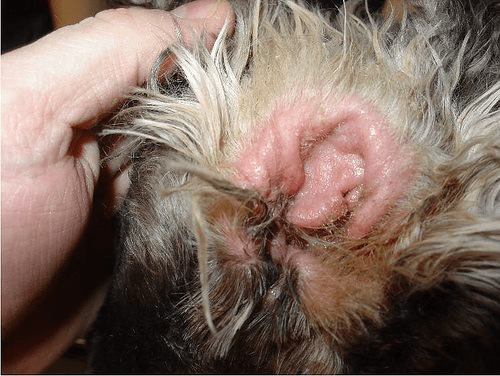Many inboxers ask howdogcare about the dog’s pus in ear, foul, or swollen red. I will now share a useful article on Dog Ear Diseases:
Ear disease is one of the most common diseases we see in animals. The medical name for otitis media is “otitis externa”. It is estimated that up to 20% of dogs are infected.

Dogs are an animal loyal to the owner, so many people like to raise. However, to keep your dog healthy and happy alongside your family, you need to be aware of some of the diseases they are prone to – especially ear problems – to find and treat them early. Signs of these ear problems include:
- Bad smell.
- Scratching or rubbing the ears and head.
- The ear is pus.
- The ear or ear is red or swollen.
- Shake your head or tilt your head to one side.
- Pain around the ear.
- Changes in appearance such as weakness or sensitivity.

Causes of ear disease: Dogs can suffer from ear problems for a variety of reasons. When we see a dog with pus in ear, bad smell, red swelling disease, it’s important to think about the possibility of getting sick:
1. Allergy
Dogs are allergic to food or something they swallow or touch their skin. In fact, ear disease can be the first sign of irritation, as the irritation changes the internal environment of the ear, so sometimes we see secondary bacterial or yeast infections. If we treat only an ear infection, it will not cure the source of the disease. We need to treat allergies.
2. Parasites
Otodectes cynotis is a common cause of cat ear disease, but less common in dogs. However, some dogs are too sensitive to ear lobes, and as a result may be very prone to itching. These dogs can scratch so much that their ear is severely damaged.
3. Ear infections
Many types of bacteria and Malassezia pachydermatis cause ear infections. Normal and healthy ears have good resistance to these organisms, but if the ear canal changes due to allergies, hormonal abnormalities, or humidity, bacteria and yeast can be proliferated. many and break the barrier of resistance.
4. Foreign objects
Vegetal stems, tiny “grip” things that cling to clothing and dog hair, can sometimes penetrate the ear. Their presence causes irritation, making dogs scratch their ears. So when you groom your dog after a walk, make sure you also check the ears for it.
5. Hormonal abnormalities
Missing or excess of different hormones can cause skin and ear disease. Thyroid hormones, glucocorticoids produced by the adrenal glands and sex hormones, all affect the health of the skin and ears.
6. Ear area
Bacteria and yeast do not need a better environment to live, a warm, dark and moist ear. Dogs with soft ears, such as Cocker Spaniels, may develop ear problems due to excessive moisture build-up in their ears.
7. Other causes
There are many rare hereditary diseases that occur in different blood types or strains and affect the ear. These diseases include dermatitis in Collies and Shetland Sheepdogs, mainly seborrhea in the Shar Peis and White-billed Toucan. Squamous cell carcinomas, melanoma and other tumors in the ear can be seen.
Diagnose
Because there are many potential causes of ear problems as dog pus in ear, bad smell, red swelling…, we can not just say that it is a bacterial ear infection, and antibiotic treatment will go away. Often, more work is needed. The veterinarian may use an ear canal to look into the ear and determine the degree of inflammation at this time, whether it is related to the eardrum (tympanic membrane) and any foreign matter, tumors, or Other potential causes of disease. The ear canal is removed, tested on a microscope slide, stained and tested for bacteria, yeast, and ticks. A thorough examination and medical examination can help determine whether this may be a hormone, allergy, or genetic disease. If there are signs of suspicion, further diagnostic testing is required. If bacterial infections do not respond to initial antibiotic therapy, bacterial cultures and susceptibility should be selected to select another antibiotic.
Treatments dog pus in ear, bad smell, red swelling
The treatment will depend on the cause of the disease and the result is secondary illnesses. Antibiotics are used to treat bacterial and fungal infections to treat yeast infections. In these medications, there are usually glucocorticoids such as dexamethasone to reduce the level of inflammation in the ear. General physical diseases, such as hormonal abnormalities or allergies, require general therapy for dogs such as hormone replacement, allergy testing and hypersensitivity ).
1. Allergy
Allergies are usually treated by ear cleaning with ear cleaning fluid, antihistamine and fatty acid supplement. Sometimes corticosteroids are needed. These medications can be taken orally, or may be applied to the allergic area. Allergy and immune therapy (hypersensitivity) may be the best way to treat ear problems.
2. Dog ear mites
Dog ear mites can cause dry, dark, fragile fragile fragments in the ear just like coffee residue. For this disease, treatment with an ear canal helps to reduce the disease, although the treatment may need to be continued for several weeks depending on the product used.
3. Men
Yeast can cause serious ear problems. We often observe a waxy brown-like secretion and an unpleasant odor. It is very helpful to wash your ears every day, but it is often difficult to treat these infections, which require special treatment because antibiotics do not melt the yeast. If you suspect a yeast infection in your dog’s ears, consult a veterinarian.
4. Bacterial Ear Infections
Bacterial ear infections can also cause pus in ear, bad smell and usually have a yellowish discharge. If the disease is severe or chronic, only ear cleaning will not cure the disease and almost always need antibiotics. Again, consult your veterinarian. Infections inside the ear can be severe if it spreads to the inner ear and inner ear. Regardless of the cause of ear disease, keep your ears and ears clean.
Clean dog ears
Your dog’s ears are L-shaped and the debris is deposited on the L-corner. To remove the debris, pour the earwash into your dog’s ear. The ear cleaner should be lightly acidic but should not cause ear pain. Massage the ear lobe within 20-30 seconds to soften and remove the debris. Wipe away the soft residue and excess residue with cotton wool. Repeat this process until you see no more debris. Let your dog shake his head to take away the excess residue. When cleaning is complete, gently wipe the ears of the dog and the area below the ear with a towel.
You can use a cotton swab to clean the inner ear and the ear canal you can see. Do not put them deep inside the ear, as it causes the debris to tighten in the ear rather than to remove the debris. Some ear infections are painful, and dogs must be anesthetized for good ear cleaning. You may find that your dog does not like to clean his ears because it is uncomfortable. Talk to the dog during the ear cleaning process. After the ear is clean, leave a slice of dry ear. You can then apply to any prescribed medication.
Prevent dog pus in ear, bad smell, red swelling
The key to keeping dogs healthy is to keep their ears clean.
– Check your dog’s ear every week. There may be a small amount of wax in normal ears.
– If your dog is swimming a lot, has an eared ear, or has a history of ear problems, he or she should regularly clean the ears (usually one to three times a week). Carry out the ear cleaning as described above.
– It is possible to skip excessive hair around the ears for more air. Follow your veterinarian’s advice on treating any potential condition that may make your dog at risk for ear problems. In the end, it should be noted that if your dog has severe discomfort, pus in ear, foul odor, or unusual ear, it should be brought to the veterinarian. If your dog has a perforation or weakened eardrum, using an earwash and medicine can be more harmful than helping.






